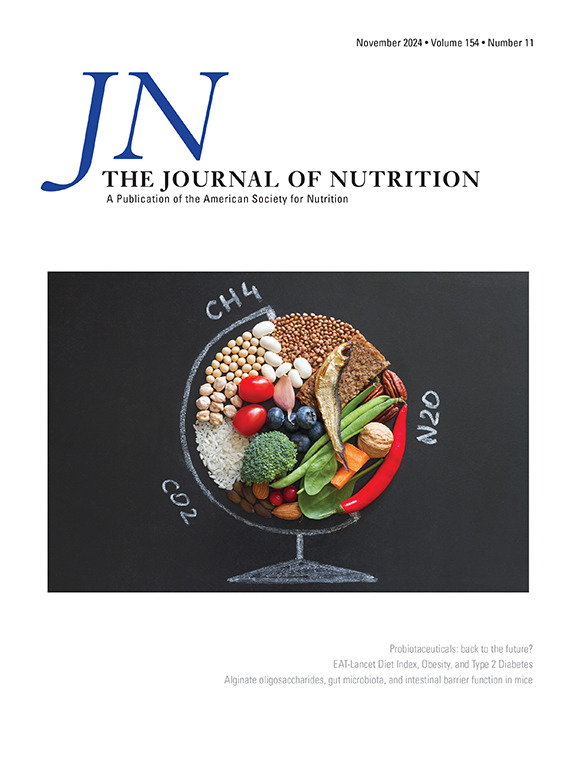美国成人饮食模式与心脏代谢健康和社会经济脆弱性的差异
IF 3.8
3区 医学
Q2 NUTRITION & DIETETICS
引用次数: 0
摘要
背景:在患有心血管疾病(CVD)或心血管代谢危险因素(即糖尿病、高血压、肥胖和血脂异常)的个体中,自然发生的饮食模式尚未得到很好的描述,特别是考虑到社会经济脆弱性。目的:我们调查了美国的主要饮食模式及其分布,包括流行的心血管疾病、心脏代谢危险因素和社会经济脆弱性。方法:对来自2009-2020年全国健康与营养检查调查的32498名非机构成年人进行横断面研究。我们使用主成分分析来确定饮食模式。使用多元线性回归,我们检验了流行CVD、心脏代谢危险因素和社会经济脆弱性(社会危险因素数量和补充营养援助计划(SNAP)参与状况)与每种模式的关系。结果:确定了四种饮食模式:加工/动物性食品(高精制谷物,添加糖,肉类,乳制品),谨慎食品(高蔬菜,坚果/种子,油,海鲜,家禽),豆类和水果/全谷物/乳制品,总共解释了29.2%的饮食差异。在调整了年龄、性别、种族和民族、队列年份和总能量摄入后,加工/动物食品模式(主成分评分差异系数β)与糖尿病(0.08[0.01,0.14])、高血压(0.11[0.06,0.16])、肥胖(0.15[0.11,0.19])、较高的社会风险评分呈正相关(p趋势结论:美国的经验饮食模式因心血管疾病、心脏代谢危险因素和社会经济脆弱性而异。改善营养的举措应考虑到这些自然发生的饮食模式及其在关键亚群中的变化。本文章由计算机程序翻译,如有差异,请以英文原文为准。
Differences in United States Adult Dietary Patterns by Cardiometabolic Health and Socioeconomic Vulnerability
Background
Naturally occurring dietary patterns are not well described among individuals with cardiovascular disease (CVD) or cardiometabolic risk factors (i.e., diabetes, hypertension, obesity, and dyslipidemia), particularly considering socioeconomic vulnerability.
Objectives
We investigated major dietary patterns in the United States and their distribution by prevalent CVD, cardiometabolic risk factors, and socioeconomic vulnerability.
Methods
This cross-sectional study analyzed data from 32,498 noninstitutionalized adults who participated in the National Health and Nutrition Examination Survey (2009–2020). We used principal component analysis to identify dietary patterns. Using multiple linear regression, we tested the association of prevalent CVD, cardiometabolic risk factors, and socioeconomic vulnerability [number of social risk factors and Supplemental Nutrition Assistance Program (SNAP) participation status] with each pattern.
Results
Four dietary patterns were identified: processed/animal foods (high-refined grains, added sugars, meats, and dairy), prudent (high vegetables, nuts/seeds, oils, seafood, and poultry), legume, and fruit/whole grain/dairy, which together explained 29.2% of the dietary variance. After adjustment for age, gender, race and ethnicity, cohort year, and total energy intake, the processed/animals foods pattern associated (β-coefficient for difference in principal component score) positively with diabetes [0.08 (0.01, 0.14)], hypertension [0.11 (0.06, 0.16)], obesity [0.15 (0.11, 0.19)], higher social risk score (P-trend < 0.001), income-eligible SNAP nonparticipation [0.16 (0.09, 0.23)], and SNAP participation [0.23 (0.17, 0.29)]. The prudent pattern associated negatively with hypertension [−0.09 (−0.14, −0.04)], obesity [−0.11 (−0.16, −0.06)], higher social risk score (P-trend < 0.001), income-eligible SNAP nonparticipation [−0.14 (−0.21, −0.06)], and SNAP participation [−0.30 (−0.35, −0.24)]. The legume pattern was associated negatively with CVD [−0.09 (−0.15, −0.02)] and obesity [−0.08 (−0.12, −0.04)], and positively with income-eligible SNAP nonparticipation [0.11 (0.04, 0.18)]. The fruit/whole grain/dairy pattern was associated positively with diabetes [0.08 (0.01, 0.15)] and negatively with hypertension [−0.21 (−0.26, −0.15)], obesity [−0.23 (−0.28, −0.18)], higher social risk score (P-trend < 0.001), and SNAP participation [−0.19 (−0.25, −0.12)].
Conclusions
Empirical dietary patterns in the United States vary by CVD, cardiometabolic risk factors, and socioeconomic vulnerability. Initiatives to improve nutrition should consider these naturally occurring dietary patterns and their variation in key subgroups.
求助全文
通过发布文献求助,成功后即可免费获取论文全文。
去求助
来源期刊

Journal of Nutrition
医学-营养学
CiteScore
7.60
自引率
4.80%
发文量
260
审稿时长
39 days
期刊介绍:
The Journal of Nutrition (JN/J Nutr) publishes peer-reviewed original research papers covering all aspects of experimental nutrition in humans and other animal species; special articles such as reviews and biographies of prominent nutrition scientists; and issues, opinions, and commentaries on controversial issues in nutrition. Supplements are frequently published to provide extended discussion of topics of special interest.
 求助内容:
求助内容: 应助结果提醒方式:
应助结果提醒方式:


